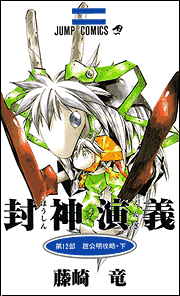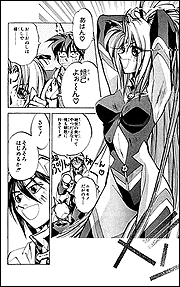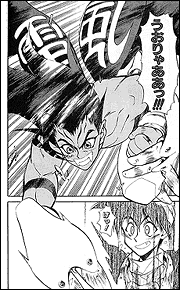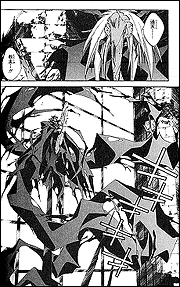 |


Volume 1-15
Story and Art by Fujisaki Ryu, loosely based on the translation of the
Chinese text by Anou Tsutomu
Copyright © 1996-1999 Fujisaki Ryu



|
 |


—by Rika Takahashi
Chinese mythology always had a distinct appeal to the Japanese market.
Or, more precisely, a certain number of tales have gotten massive
recognition in Japan. The most well known would be the legend of the
Monkey King (known as Saiyuuki in Japan), and everyone knows a story
that derived its basic concept from this tale—DRAGON
BALL. Many Japanese folks know about the legend of the Three
Kingdoms, or even SUIKODEN after Konami made a series of role-playing
games about the tale of the 108 stars. But the last of the "four
big ancient Chinese tales" as seen by the Japanese culture, HOUSHIN ENGI, had seen little time in the limelight.
 However, halfway through 1996, Fujisaki Ryu returned to the pages
of Weekly Jump (the first time since his short-lived series PSYCHO+) with a comic series loosely based on a
Japanese translation of this ancient Chinese tale which some people dub
"the first science-fiction novel in history." However, the key word there
is "loosely", as what we see in this comic series was not exactly what the
ancient Chinese authors had in mind. However, halfway through 1996, Fujisaki Ryu returned to the pages
of Weekly Jump (the first time since his short-lived series PSYCHO+) with a comic series loosely based on a
Japanese translation of this ancient Chinese tale which some people dub
"the first science-fiction novel in history." However, the key word there
is "loosely", as what we see in this comic series was not exactly what the
ancient Chinese authors had in mind.
 The basic premise of the comic version is the same as that of
the original novel; and that is basically what this reviewer has been
writing in the Jump capsule synopses: Taikoubou is a sennin (a wizard
of sorts) sent on a mission to seal away the souls of the evil temptress
Datsuki and her henchmen because she is ruining the land of Chouka (also
called "Ying") by controlling Chuuoh, its king. The task seems easy enough
in the beginning, but Taikoubou notices that some of the names are names he
didn't want to see—namely, some of them are known to be ultra-powerful.
Add to that the fact that the list of beings to be sealed away is only about
half full (i.e. leaving lots of room for stray casualties), and you've got
one massive project that ends up spanning years and years. And this
project (aptly named the Houshin Project) is more than meets the eye, and
soon starts to involve the homelands of the sennin as well as the
human world. The basic premise of the comic version is the same as that of
the original novel; and that is basically what this reviewer has been
writing in the Jump capsule synopses: Taikoubou is a sennin (a wizard
of sorts) sent on a mission to seal away the souls of the evil temptress
Datsuki and her henchmen because she is ruining the land of Chouka (also
called "Ying") by controlling Chuuoh, its king. The task seems easy enough
in the beginning, but Taikoubou notices that some of the names are names he
didn't want to see—namely, some of them are known to be ultra-powerful.
Add to that the fact that the list of beings to be sealed away is only about
half full (i.e. leaving lots of room for stray casualties), and you've got
one massive project that ends up spanning years and years. And this
project (aptly named the Houshin Project) is more than meets the eye, and
soon starts to involve the homelands of the sennin as well as the
human world.
 So, why is this considered a "science-fiction" work? That is
because each sennin has what is called a Paopei—and
these things are items with magical effects ... but they are used in much the
same way as the characters in STAR TREK use phasers.
(Really.) And in Fujisaki's rendition, we see characters with what can only
be described as lightsabers! So, why is this considered a "science-fiction" work? That is
because each sennin has what is called a Paopei—and
these things are items with magical effects ... but they are used in much the
same way as the characters in STAR TREK use phasers.
(Really.) And in Fujisaki's rendition, we see characters with what can only
be described as lightsabers!
 And even then, how can someone change things around in such a story?
Well, there have been minute changes of when a given character gets sealed
away. So even if you are indeed familiar with the original novel (in either
the original Chinese text or a translation), Fujisaki will keep you guessing
as to who will survive in his rendition. And despite all the strings of kanji
that are really hard to find (this reviewer notices a lot of katakana in the
names of characters in fan sites), the series is strewn with many furigana to
make it rather simple reading if you realize that a lot of the "harder" words
are proper names! And even then, how can someone change things around in such a story?
Well, there have been minute changes of when a given character gets sealed
away. So even if you are indeed familiar with the original novel (in either
the original Chinese text or a translation), Fujisaki will keep you guessing
as to who will survive in his rendition. And despite all the strings of kanji
that are really hard to find (this reviewer notices a lot of katakana in the
names of characters in fan sites), the series is strewn with many furigana to
make it rather simple reading if you realize that a lot of the "harder" words
are proper names!
 What appeals the most to the fans of this comic series is the art.
Not only has Fujisaki shown much improvement as the series goes on, he takes
the utmost care in making sure that each and every character that he introduces
has a different look and feel. Thus, you can immediately tell the main
characters apart by sight (now, mind you, whether or not you learn to match
their names with their faces is a completely different question ...) And even
more so, his art style is such that it can successfully render an "old" tale in
a more "modern" sense. His illustrations on the cover pages, especially those
in color, give a feeling of the ancient times—yet his lines are not as
heavy or detailed as what most perceive as "old-school" art. This mix of old
and new, both in plot and in art, seems to have hit it home with many
doujinshi authors in Japan, amateur to professional. You would be
amazed at just how many HOUSHIN fan-sites there are in
Japan! What appeals the most to the fans of this comic series is the art.
Not only has Fujisaki shown much improvement as the series goes on, he takes
the utmost care in making sure that each and every character that he introduces
has a different look and feel. Thus, you can immediately tell the main
characters apart by sight (now, mind you, whether or not you learn to match
their names with their faces is a completely different question ...) And even
more so, his art style is such that it can successfully render an "old" tale in
a more "modern" sense. His illustrations on the cover pages, especially those
in color, give a feeling of the ancient times—yet his lines are not as
heavy or detailed as what most perceive as "old-school" art. This mix of old
and new, both in plot and in art, seems to have hit it home with many
doujinshi authors in Japan, amateur to professional. You would be
amazed at just how many HOUSHIN fan-sites there are in
Japan! 
Published by Shueisha (serialized in Weekly Jump from #28, 1996)
15 vols out, ongoing
approx. 200 black/white pages each
vol. 1: ISBN4-08-872141-1 c9979
vol. 2: ISBN4-08-872142-x c9979
vol. 3: ISBN4-08-872143-8 c9979
vol. 4: ISBN4-08-872144-6 c9979
vol. 5: ISBN4-08-872145-4 c9979
vol. 6: ISBN4-08-872146-2 c9979
vol. 7: ISBN4-08-872147-0 c9979
vol. 8: ISBN4-08-872529-8 c9979
vol. 9: ISBN4-08-872552-2 c9979
vol. 10: ISBN4-08-872575-1 c9979
vol. 11: ISBN4-08-872602-2 c9979
vol. 12: ISBN4-08-872627-8 c9979
vol. 13: ISBN4-08-872654-5 c9979
vol. 14: ISBN4-08-872698-7 c9979
vol. 15: ISBN4-08-872723-1 c9979
¥ 390 plus taxper volume
Available now in Japan
Where to buy |
 |

